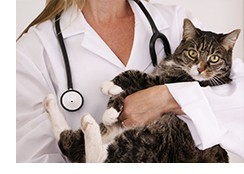
Hyperthyroidism in cats is one of the most common hormonal diseases in our feline friends. Most cats are 8 years or older and can be any breed or sex. The disease is caused by excess production of thyroid hormone by the thyroid glands. Thyroid hormone regulates metabolic rate, so cats with too much thyroid hormone in their circulation their heart races, can become hyperactive, and lose weight even though in most cases they have an excellent appetite.
What is the cause of hyperthyroidism in cats?
The most common cause is either a benign tumour or excessive growth (hyperplasia) of the thyroid gland. The reason for the excessive growth of the gland is unknown but is thought to involve multiple factors such as genetics, diet, immunity and environment. Rarely there may be a malignant tumour causing the symptoms.
What are the effects of hyperthyroidism?
Clinical signs are quite vague in the early stages of the disease. Often the disease is detected incidentally during the cat’s annual health check when subtle signs are noted by the veterinarian.
The most common signs are:
- Weight loss
- Increased appetite
- Hyperactivity/restless behaviour/grumpiness
Other signs include:
- Rapid heart rate (and often a heart murmur)
- Increased thirst and urination
- Vomiting or diarrhea
- Some cats become lethargic and have a reduced appetite but this is less common.
Cats with hyperthyroidism can develop high blood pressure (hypertension) and abnormally thick heart muscle (hypertrophic cardiomyopathy). These problems usually resolve when the hyperthyroidism is effectively treated.
Diagnosing hyperthyroidism
The diagnosis is made by your Veterinary Surgeon after carrying out a physical examination and specific blood tests. The thyroid glands are occasionally enlarged enough to be felt on the side of the neck. Specifically thyroid hormone (T4) level is measured and an elevated level confirms the diagnosis. In addition it is important to check the function of the kidneys prior to and soon after commencing treatment because blood flow to the kidneys is decreased when the metabolism slows down and underlying kidney disease will be exacerbated.
Treatment
Hyperthyroidism in cats can be treated in 3 ways:
- Radioiodine is a safe treatment for hyperthyroidism. It provides a cure in 98% of cases after a single dose. The treatment must be done at a facility that is licensed to handle the radioactive iodine. Cats must be isolated at the facility until the radiation level has fallen to a level that allows them to be handled safely by their family.
- Anti-thyroid drug therapy must be given for the rest of the cat’s life in order for the disease to be controlled. It is not a cure and symptoms will recur if treatment is stopped. Medication must be given 2 to 3 times daily. Regular veterinary checks including blood tests must be carried out to monitor the effect of the medication and highlight any detrimental side effects. Side effects include loss of appetite, lethargy and vomiting. Less commonly the side effects are more severe (low white blood cell counts, liver disorders, problems with clotting, skin problems)
- Surgical removal carries the risk of accidental damage to the parathyroid glands which are situated close to the thyroid glands and are necessary for regulating calcium levels in the blood. Damage to the parathyroid glands is a life-threatening condition. Also general anaesthesia carries increased risk in many hyperthyroid cats

